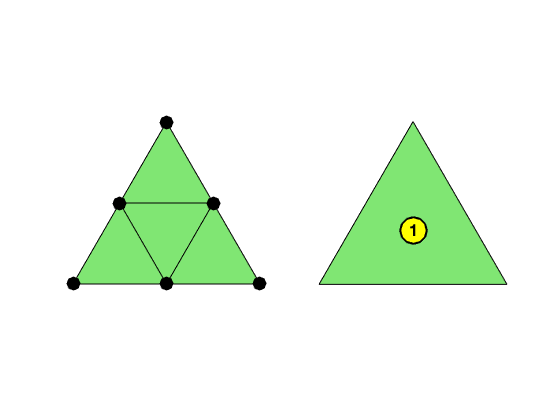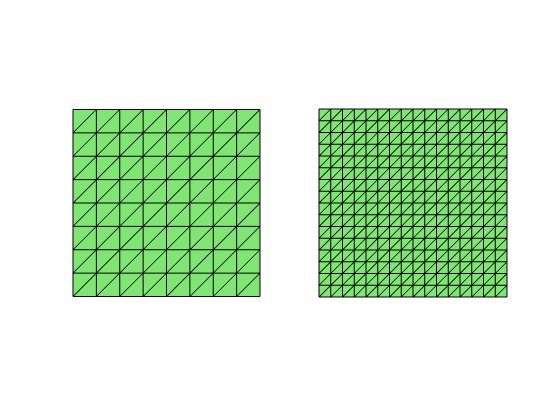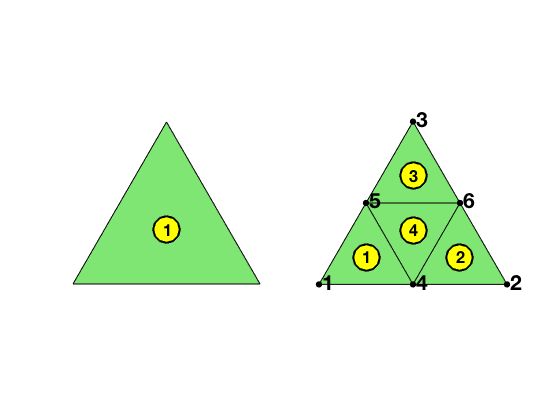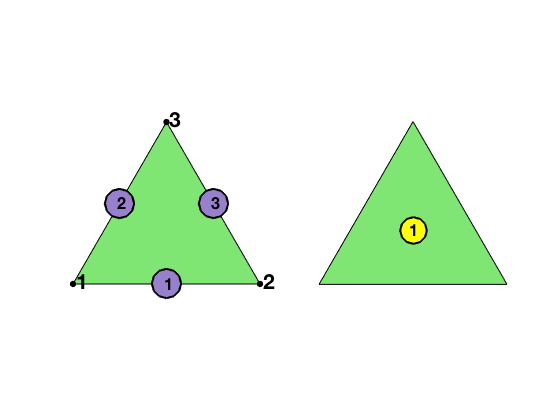Project: Finite Element Methods for Stokes Equations
The purpose of this project is to implement some simple and popular finite element pairs for solving the Stokes equations in two dimensions.
Part I: isoP2-P0 element
Given a triangulation (node,elem), the velocity space $\mathbf u = (u, \; v)$ is the linear
finite element space on the uniform refinement of (node,elem) and the pressure is piecewise constant space on the current mesh.
node = [0,0; 1,0; 0.5, sqrt(3)/2];
elem = [1, 2, 3];
subplot(1,2,2); showmesh(node,elem); findelem(node,elem);
[node,elem] = uniformrefine(node,elem);
subplot(1,2,1); showmesh(node,elem); findnode(node,'all','noindex','MarkerSize',36);

Step 1: Data Structure
The current mesh will be refered as a coarse mesh and a uniform refined mesh is the fine mesh.
[node,elem] = squaremesh([-1,1,-1,1],0.25);
subplot(1,2,1); showmesh(node,elem);
NTc = size(elem,1);
% Uniform refinement to get a fine grid
[node,elem] = uniformrefine(node,elem);
subplot(1,2,2); showmesh(node,elem);

In the uniformrefine, the new elements are added in such an order that
triangles (t, NTc + t, 2*NTc + t, 3*NTc + t) are refined from the same
parent, where NTc is the number of triangles in the coarse grid.
Step 2: Form the matrix equation for Laplacian
Call your code on the linear finite element method for Poisson equation to get the discrete Laplacian matrix. See Project: Linear Finite Element Methods. Merge two copies of the Laplacian matrix using blkdiag.
Step 3: Form the matrix for the divergence operator
node = [0,0; 1,0; 0.5, sqrt(3)/2];
elem = [1, 2, 3];
subplot(1,2,1); showmesh(node,elem); findelem(node,elem);
[node,elem] = uniformrefine(node,elem);
subplot(1,2,2); showmesh(node,elem); findnode(node); findelem(node,elem);

In one triangle, the $-div$ matrix will be a matrix of size $12\times 1$ which maps the velocity (12 dimensions as the piecewise linear in the fine mesh and two components) to the coarse triangle. Expand the linear element into the barycentric coordinate, and compute $\nabla \lambda_i$ on the fine grid
[Dlambda,area] = gradbasis(node,elem);
Assemble the sparse matrice for the divergence operator on the fine grid by computing \(-\int_t [\partial_x \lambda_1 \; \partial_x \lambda_2 \; \partial_x \lambda_3 \; \partial_y \lambda_1 \; \partial_y \lambda_2 \; \partial_y \lambda_3]\; dx.\)
Merge four terms in the above matrix to compute the divergence operator on the coarse grid \(-\int_{t\cup (NTc + t) \cup (2NTc + t) \cup (3NTc + t)} \, \partial_x u + \partial_y v \, dx.\)
Step 4: Boundary conditions
Modify the right hand side to include Dirichlet or Neumann boundary conditions. It is the same as the Poisson equation but remember to repeat for each component of the velocity. For non-homogenous Dirichlet boundary condition, you need to modify the continunity equation too. Record freeDof of velocity.
Step 4: Solve the linear system
Form a big matrix bigA = [A B'; B sparse(Np,Np)] and use the
direct solver to solve bigA(bigFreeDof,bigFreeDof)\bigF(bigFreeDof)
Since the pressure is unique up to a constant, you need to eliminate the
constant kernel by not including one component of pressure vector in the
bigFreeDof. After you get the solution, you need to modify p such that
its weighted mean value is zero.
Part II: nonforming P1-P0 element
Step 1: Data Structure
Since the unknowns are associated to edges, you need to generate edges and more importantly the indices map from a triangle to global indices of its three edges. The edges are labled such that the i-th edge is opposite to the i-th vertex for i=1,2,3.
clear all;
node = [0,0; 1,0; 0.5, sqrt(3)/2];
elem = [1, 2, 3];
[elem2edge,edge] = dofedge(elem);
subplot(1,2,1); showmesh(node,elem); findnode(node); findedge(node,edge);
subplot(1,2,2); showmesh(node,elem); findelem(node,elem);
display(elem2edge)
elem2edge =
3 2 1

Step 2: Form the matrix equation
Figure out the basis of CR element using the barycenteric coordinates.
Call your code for linear finite element methods in Part I with the correct correction to CR element.
Compute the righ hand side using three middle point rule. It is even simplier than linear element case.
Step 3: Boundary conditions
Similar as in the linear element case. Just be careful on the Dirichlet boundary condition, you need to evaluate g_D at middle points of boundary edges.
To find out the boundary edges, use
s = accumarray(elem2edge(:), 1, [size(edge,1) 1]);
Then idx = (s==1) is the index of boundary edges and the set for (s==2) is interiori (free) edges.
Step 4: Solve the linear system
Same as the first Part.
Test Example
We use a simple model of colliding flow with analytic solutions to test the code. The domain is $[-1,1]^2$ and the analytic solution is:
\[u = 20xy^3; v = 5x^4 - 5y^4; \quad p = 60x^2y - 20y^3 + constant.\]Compute the data f and Dirichlet boundary condition g_D and solve Stokes equation on the unit square using methods in Part I,II and check the rate of convergence.
Comments